English [🇺🇸]
I showed here a few days ago how I use the @surfgurupro website to read the wave forecast, right? But it's one thing to read charts and maps, and another is to do it "in practice".
And so, you arrived at the beach, now what? Is there a channel? Does it have a rip current? Where do I enter? No forecast will tell you these types of things, so you need to learn by doing it.
First, I'll reinforce here: before going into the sea to surf, take at least 10 - 15 minutes to observe
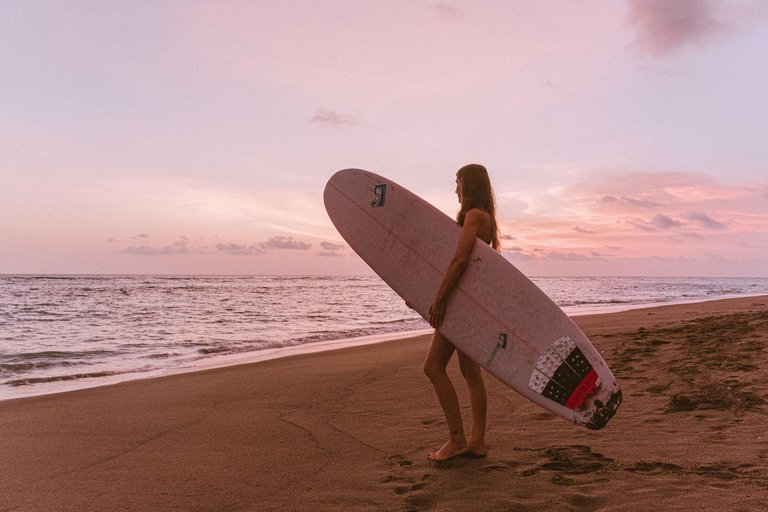
Photo by Anna Shvets (Pexels)
Yes! Observe the quality of the waves, where people are catching waves, see where people are entering, if people are being "carried away" by some current in the sea... and if necessary, talk to someone who has just left to find out how it is, if there is current, if it is "pulling" in some direction, where it is better to enter, etc. All this will help you!
But what if you can't do any of that? Imagine arriving at a beach without a crowd, and you and your friends will be the first to enter the sea. How do we evaluate all this, being on the sand? Look for the highest possible place and observe! Now, let's know what we must identify before entering the sea.
Channels: where the rip currents are
The channels are the places on the beaches where there is no wave breaking or where they break less frequently (that place where the bather/swimmers want to enter, but it is dangerous!). As for us surfers, the channels are easier places to enter, not only because you won't be soaking it in your head the whole time (lol!) but also because there's probably a rip current there, which is nothing more than a current that will take you more easily into the sea.
Based on the reasoning that waves break in relatively shallow places (it can be a sand, rock, or coral bank), the channels where there is no wave breaking are usually deeper. So, channels and sandbars are usually interspersed or can be found on the edges or between coral or rocky banks.
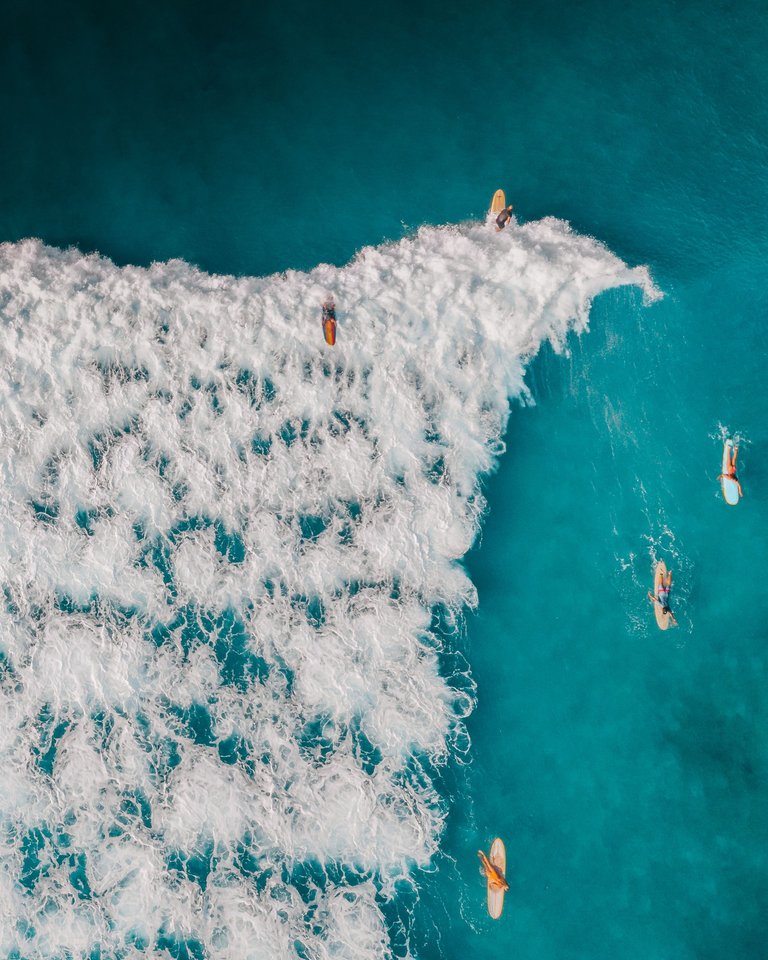
Waves breaking on the left and channel on the right. Photo by Jess Loiterton (Pexels)
So imagine that the channel is a corridor with few waves, and the water may even have a different color (usually darker) due to the depth or agitation of the sand at the bottom. If you find a channel, that's the easiest place to get into the sea to surf and reach the lineup.
That way, the best spots are on the side of the channel. If you are looking at the beach and identify a canal right in front of you, on your right, you will see waves opening to the right and "dying" in the channel, and on your left, you will see waves opening to the left and "dying" in the channel. The channels may not be easy to identify, but if we follow this logic, we can also find the "closeouts" in the channels, which is the case when a left and a right-handed wave meet.
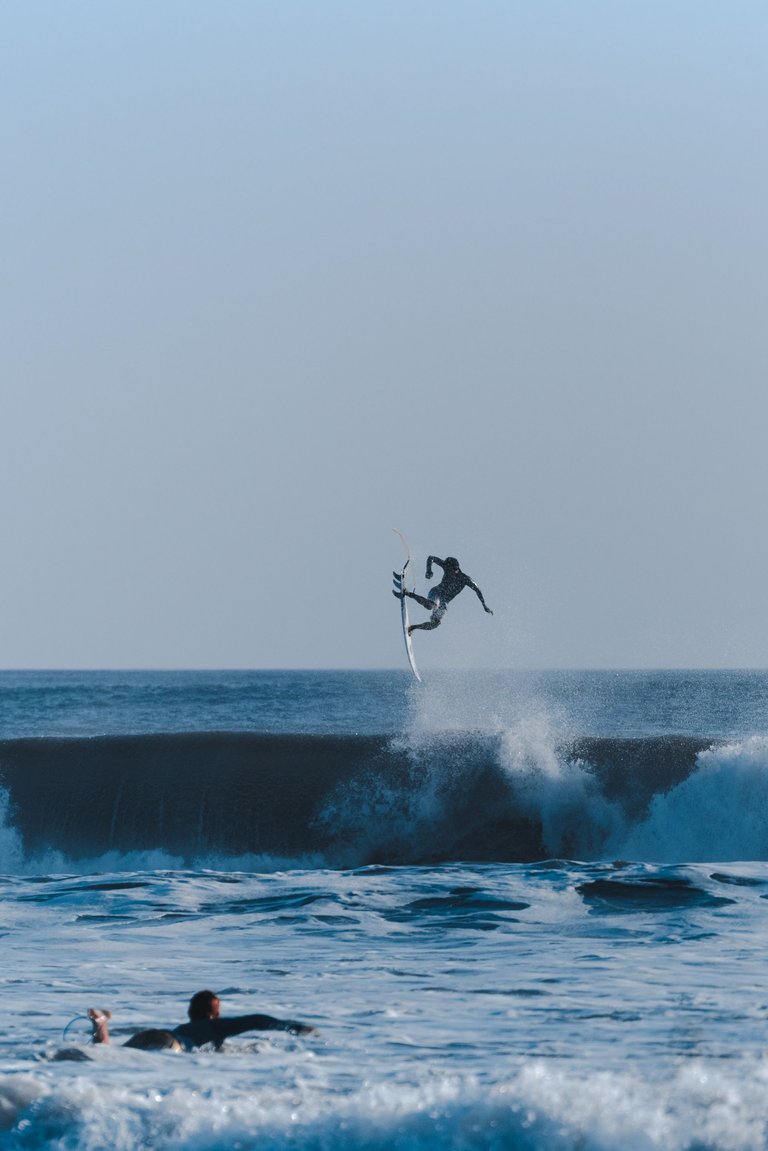
Closeout. Photo by Bob Ward (Pexels)
Tides
The tides directly influence our surfing, depending on the peak and the type of bottom of that peak. Depending on the depth, spots with coral or rock banks generally work best at lower tides.
You must be careful because a shallow tide can show the rocks and corals and cause accidents. In this case, the greater probability is to find more tubular waves, as I explained here. But when we have high tides, depending on the type of bottom of the place you are going to surf, as the depth concerning the bottom increases, it can still generate waves, but perhaps weaker or fatter.
When arriving at a beach, it is usually very easy to identify whether the tide is high or low, especially if you already frequent that place. But generally, on a sandy beach, for example, if you can see a strip of dry sand and then a strip of wet sand before reaching the water, the tide is probably low. Otherwise, the tide is high.
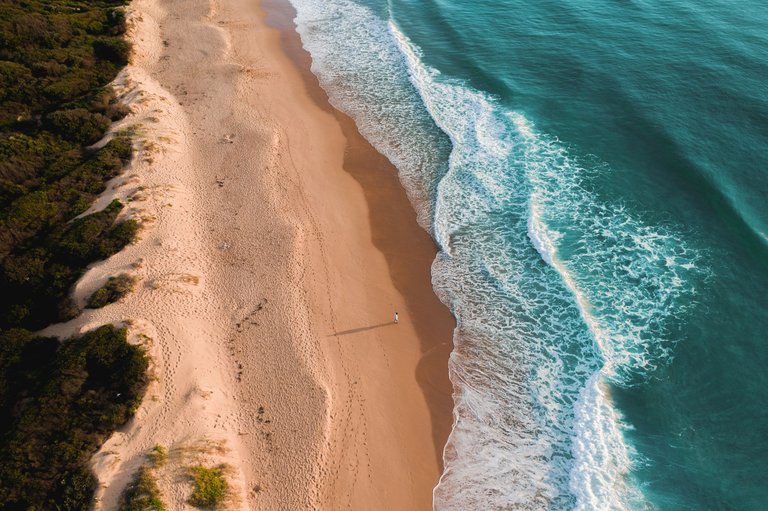
Low tide. Photo by Ben Mack (Pexels)
Another reference is the rocky shores at the ends of the beaches. At low tides, it is possible to see a darker band on the rocks, where some marine organisms such as mussels, barnacles, and algae are also usually encrusted. Otherwise, the tide is high.
Remember that tides are cyclical; we usually have two high tides and two low tides daily. So it's always good to consult the tide tables and know how they work, mainly where you will surf.
Wind direction: onshore or offshore?
The wind is another essential parameter in surfing; you can only talk about reading the sea at the beach if you talk about the wind. I've already explained here that the offshore wind is usually the best for surfing, whether small or bigger waves.
To recapitulate, the offshore wind is the one that comes from the land towards the sea, and the onshore wind is the one that comes from the sea towards the land. On the beach, this is pretty easy to spot! Coconut trees, trees, and flags are good elements to observe to know where the wind is coming from. Is the wind weak? You can use your hair, the yoke, or even throw sand up to identify the direction. Remember, we always refer to the direction of the wind as where it comes from, not where it goes.
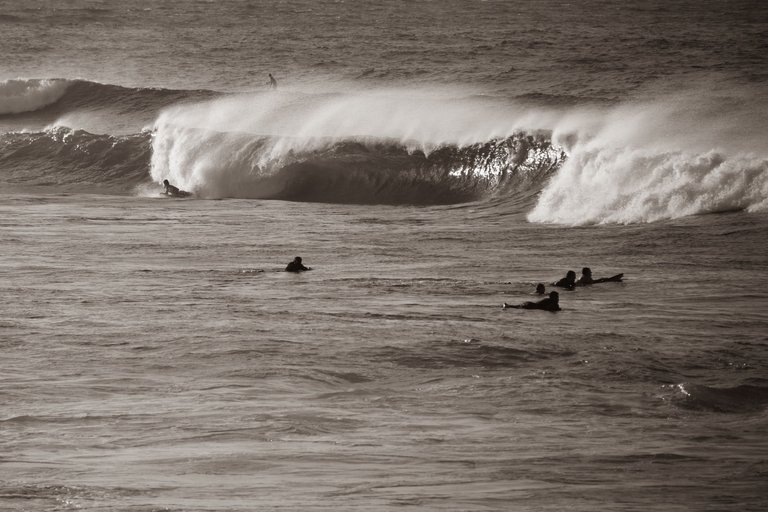
Offshore wind. Photo by Jess Loiterton (Pexels)
In addition, the offshore wind tends to make the waves more aligned, and the onshore wind makes the waves more messy and without a defined formation. Easy, right?
At the lineup
Once you reach the lineup, establish landmarks on land. That way, you'll know where you are, if the current pulls you in any direction, and you'll always be sure you're at the right spot.
And finally, here are some silly, practical, and not always so obvious tips!
People want to refrain from surfing where there's a crowd, but... where there's a crowd is probably where the best waves are rolling. And where no one is surfing, it's perhaps a channel.
On sandy bottom beaches, the bottom can change from time to time, yet a ditch can remain in the same spot for weeks, assuming there are no storms or undertows during that period. So this is a good tip: if you usually go to the beach daily, pay attention to these details even more!
On more crowded and urbanized beaches, rip current locations are usually signaled by red flags or signs by lifeguards. The risk for surfers is slightly lower, so go in only if you are sure.
Last but not least, always be cautious when entering the sea
The sea is in charge. But everything around gives you signs and serves as a learning experience to understand the dynamics of the sea and waves.
Ahh, and never surf alone! In addition to being more enjoyable surfing with friends, you will be safer in the company of someone than alone.
Do you have any more tips? Did I forget something? Tell me here in the comments!
About me
Biologist, Photographer, Content Producer, and Community Builder. Please take a look at my introduction post to get to know me better.
My social networks:
- Personal Instagram – me, my husband, my cats, sustainability, biology curiosities, and adventures: @crisciacm
- Professional Instagram – surf, nature, and people photos: @crisciacesconettophoto
- Youtube Channel - surf videos: @crisciacesconetto
- My profile at Thatsgnar.ly - crisciacesconetto
- Twitter – Não sei o que fazer por lá, mas existe: @crisciacm
Português - BR [🇧🇷]
Como melhorar a leitura do mar pro surf
Mostrei aqui a alguns dias atrás como eu uso o site do @surfgurupro para ler a previsão das ondas, certo? Mas uma coisa é ler gráficos e mapas, e outra coisa é fazer isso "na prática".
E então, você chegou na praia, e agora? Tem vala ou canal? Tem corrente? Por onde eu entro? Esses são os tipos de coisas que previsão nenhuma vai te falar, então é necessário aprender na prática mesmo.
Primeiro, vou reforçar aqui: antes de entrar no mar pra surfar, tire pelo menos uns 10 - 15 minutos só pra observar

Foto de Anna Shvets (Pexels)
Isso! Observe a qualidade das ondas, onde as pessoas estão pegando onda, veja por onde as pessoas estão entrando, se as pessoas estão sendo "levadas" por alguma corrente no mar... e se necessário converse com alguém que acabou de sair pra saber como está, se tem corrente, se tá "puxando" pra alguma direção, onde é melhor de entrar, etc. Tudo isso vai te ajudar!
Mas e se você não conseguir fazer nada disso? Imagina que você chegou numa praia, sem crowd e você e seus amigos serão os primeiros a entrar no mar. Como avaliar isso tudo, estando da areia? Procure o lugar mais alto possível e observe! Agora vamos saber o que precisamos identificar antes de entrar no mar.
Valas ou canais: onde estão as correntes de retorno
As valas são os locais das praias onde há ausência de quebra de ondas, ou onde elas quebram com menos frequência (aquele lugar onde o banhista quer entrar, mas é perigoso!). Já para nós surfistas, as valas são locais mais fáceis de entrar não só porque você não vai ficar tomando na cabeça o tempo inteiro (rs!), mas também porque ali provavelmente tem uma corrente de retorno, que nada mais é que uma corrente que vai te levar com mais facilidade para dentro do mar.
Partindo do raciocínio que as ondas quebram em locais relativamente rasos (pode ser um banco de areia, de pedras ou de coral), as valas, onde não há quebra de ondas, geralmente são mais fundas. Por isso normalmente, valas e bancos de areia são intercalados, ou podem ser encontradas nas bordas ou entre bancos de coral ou pedra.

Ondas quebrando a esquerda e canal a direita. Foto de Jess Loiterton (Pexels)
Então imagine que a vala é um corredor, com poucas ondas e a água pode até ter uma coloração diferente (geralmente mais escura) devido a profundidade ou agitação da areia no fundo. Se você encontrar uma vala, é por ali o lugar mais fácil pra você conseguir entrar no mar para surfar e chegar no outside.
Dessa forma, os melhores picos estão do lado das valas. Se você está olhando para a praia e identifica uma vala bem na sua frente, à sua direita você vai ver ondas abrindo para a direita e "morrendo" na vala; e à sua esquerda, você vai ver ondas abrindo para a esquerda e "morrendo" na vala. As valas podem não ser tão fáceis de identificar, mas se formos por essa lógica, podemos encontrar as "fechadeiras" também nas valas, que é o caso de quando uma esquerda e uma direita se encontram.

Fechadeira. Foto de Bob Ward (Pexels)
Maré
As marés influenciam diretamente no nosso surf, dependendo do pico e do tipo de fundo daquele pico. Locais com bancos de coral ou de pedra, dependendo da profundidade, geralmente funcionam melhor nas marés mais baixas.
Só é preciso tomar muito cuidado porque uma maré baixa demais pode evidenciar as pedras e corais e causar acidentes. Nesse caso, a probabilidade maior é de encontrar ondas mais tubulares, como já expliquei aqui.
Já quando temos marés altas, também dependendo do tipo de fundo do local que você vai surfar, como a profundidade em relação ao fundo aumenta, ainda pode gerar ondas, mas talvez mais fracas ou mais gordas.
Chegando numa praia, geralmente é bem fácil identificar se a maré está alta ou baixa, principalmente se você já frequenta aquele local. Mas no geral, numa praia de areia, por exemplo, se você consegue ver uma faixa de areia seca e depois uma faixa de areia úmida antes de chegar na água, a maré provavelmente está baixa. Do contrário, a maré está alta.

Maré baixa. Foto de Ben Mack (Pexels)
Uma outra referência são os costões rochosos nas extremidades das praias. Nas marés baixas é possível ver uma faixa mais escura nas pedras, onde também geralmente estão incrustados alguns organismos marinhos como mexilhões, cracas e algas. Do contrário, a maré está alta.
Lembre-se que as marés são cíclicas e temos normalmente duas marés altas e duas marés baixas por dia. Então é sempre bom consultar as tábuas de maré e saber como elas funcionam, principalmente onde você vai surfar.
Direção dos ventos: maral ou terral?
O vento é outro parâmetro essencial no surf e não dá pra falar de leitura do mar quando você tá na praia sem falar de vento. Já expliquei aqui que o vento terral é normalmente o melhor vento para o surf, seja ele de marolas ou de ondas maiores.
Recapitulando, o vento terral é o que vem da terra em direção ao mar; e o vento maral é o que vem do mar em direção a terra. Na praia, isso é bem fácil de identificar! Coqueiros, árvores, bandeiras são bons elementos pra se observar pra conseguir saber de onde o vento está vindo. O vento tá fraco? Você pode usar seu cabelo, a canga, ou até jogar areia pra cima pra conseguir identificar a direção. Lembre-se, nos referimos a direção do vento sempre de onde ele vem e não para onde ele vai.

Vento terral. Foto de Jess Loiterton (Pexels)
No mais, o vento terral tende a deixar as ondas mais alinhadas e o vento maral deixa as ondas mais bagunçadas e sem uma formação definida. Fácil, né?
De dentro do mar
Assim que você chegar no outside, estabeleça pontos de referência em terra. Dessa forma você vai ter ideia de onde você está, se a correnteza está te puxando para alguma direção, e você vai ter sempre certeza que você tá no pico.
E pra finalizar, vão aqui umas dicas bobas, práticas e nem sempre tão óbvias!
Ninguém quer surfar onde tem crowd, mas... onde tem crowd é provavelmente onde estão rolando as melhores ondas. E onde não tem ninguém surfando, provavelmente é uma vala.
Em praias de fundo de areia, o fundo pode mudar de tempos em tempos, ainda assim, durante semanas uma vala pode permanecer no mesmo local, assumindo que não haja tempestades ou ressacas durante esse período. Então essa é uma boa dica, se você costuma ir à praia todos os dias, observe ainda mais esses detalhes!
Em praias mais movimentadas e urbanizadas, os locais das correntes de retorno são normalmente sinalizados pelos guarda-vidas com bandeiras vermelhas ou placas. O risco para os surfistas é um pouco menor, então só entre se você se garante.
Por fim, mas não menos importante, tenha sempre muita cautela e cuidado quando for entrar no mar
É ele que manda. Mas tudo em volta te dá sinais e serve de aprendizado pra entender a dinâmica do mar e das ondas.
Ahh, e nunca surfe sozinho! Além de ser mais prazeroso surfar com amigos, você vai estar mais seguro na companhia de alguém do que sozinho.
Tem alguma dica a mais? Esqueci de algo? Me fala aqui nos comentários!
Sobre mim
Bióloga, Fotógrafa, Produtora de Conteúdo e Construtora de Comunidades. Dá uma olhada no meu post de introdução pra me conhecer melhor.
Minhas redes sociais:
- Instagram pessoal – eu, meu marido, meus gatos, sustentabilidade, curiosidades biológicas e aventuras: @crisciacm
- Instagram profissional – fotos de surf, natureza, e pessoas: @crisciacesconettophoto
- Canal no Youtube - videos de surf: @crisciacesconetto
- Meu perfil no Thatsgnar.ly - crisciacesconetto
- Twitter – I don't know what to do there, but it exists: @crisciacm
Congratulations @crisciacm! You have completed the following achievement on the Hive blockchain And have been rewarded with New badge(s)
Your next target is to reach 3000 upvotes.
You can view your badges on your board and compare yourself to others in the Ranking
If you no longer want to receive notifications, reply to this comment with the word
STOPCheck out our last posts: